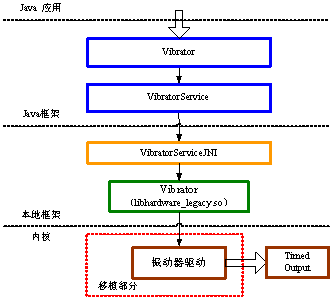Android平台中振动器系统详解
Email:[email protected]
Blog:http://blog.csdn.net/yinwei520
Author:Yww
Time:2011-9-24
Update:
(转载请注明出处,谢谢)
这里引用《Android系统级深入开发——移植与调试》一书中的解释,关于真正的vibrator代码分析,是以我项目中的代码为基础。
一: 振动器系统结构和移植内容
振动器负责控制引动电话的振动功能,Android中的振动器系统是一个专供这方面功能的小系统,提供根据时间振动的功能。
振动器系统包含了驱动程序、硬件抽象层、JNI部分、Java框架类等几个部分,也向Java应用程序层提供了简单的API作为平台接口。
Android振动器系统的基本层次结构如图23-1所示。
图23-1 Android振动器系统的基本层次结构
1 振动器部分的结构
Android振动器系统自下而上包含了驱动程序、振动器系统硬件抽象层、振动器系统Java框架类、Java框架中振动器系统使用等几个部分,其结构如图23-2所示。
图23-2 Android振动器系统的结构
自下而上,Android的振动器系统分成了以下部分。
(1)驱动程序:特定硬件平台振动器的驱动程序,通常基于Android的Timed Output驱动框架实现
(2)硬件抽象层
光系统硬件抽象层接口路径为:hardware/libhardware_legacy/include/hardware_legacy/ vibrator.h
振动器系统的硬件抽象层在Android中已经具有默认实现,代码路径:
hardware/libhardware_legacy/vibrator/vibrator.c
振动器的硬件抽象层通常并不需要重新实现,是libhardware_legacy.so的一部分。
(3)JNI部分
代码路径:frameworks/base/services/jni/com_android_server_VibratorService.cpp
这个类是振动器的JNI部分,通过调用硬件抽象层向上层提供接口。
(4)Java部分
代码路径:
frameworks/base/services/java/com/android/server/VibratorService.java
frameworks/base/core/java/android/os/Vibrator.java
VibratorService.java通过调用,VibratorService JNI来实现com.android.server包中的VibratorService类。这个类不是平台的API,被Android系统Java框架中的一小部分调用。
Vibrator.java文件实现了android.os包中的Vibrator类,这是向Java层提供的API。
2 移植内容
针对特定的硬件平台,振动器系统的移植有两种方法。
第一种方法(通常情况):由于已经具有硬件抽象层,振动器系统的移植只需要实现驱动程序即可。这个驱动程序需要基于Android内核中的Timed Output驱动框架。
第二种方法:根据自己实现的驱动程序,重新实现振动器的硬件抽象层定义接口(需要在libhardware_legacy.so库中),由于振动器硬件抽象层的接口非常简单,因此这种实现方式也不会很复杂。
二: 移植与调试的要点
1 驱动程序
Vibrator的驱动程序只需要实现振动的接口即可,这是一个输出设备,需要接受振动时间作为参数。由于比较简单,因此Vibrator的驱动程序可以使用多种方式来实现。
在Android中,推荐基于Android内核定义Timed Output驱动程序框架来实现Vibrator的驱动程序。
Timed Output的含义为定时输出,用于定时发出某个输出。实际上,这种驱动程序依然是基于sys文件系统来完成的。
drivers/staging/android/目录timed_output.h中定义timed_output_dev结构体,其中包含enable和get_time这两个函数指针,实现结构体后,使用timed_output_dev_register()和timed_output_dev_unregister()函数注册和注销即可。
Timed Output驱动程序框架将为每个设备在/sys/class/timed_output/目录中建立一个子目录,设备子目录中的enable文件就是设备的控制文件。读enable文件表示获得剩余时间,写这个文件表示根据时间振动。
Timed Output驱动的设备调试,通过sys文件系统即可。
对于Vibrator设备,其实现的Timed Output驱动程序的名称应该为“vibrator”。因此Vibrator设备在sys文件系统中的方法如下所示:
# echo "10000" > /sys/class/timed_output/vibrator/enable
# cat /sys/class/timed_output/vibrator/enable
3290
# echo "0" > /sys/class/timed_output/vibrator/enable
对于enable文件,“写”表示使能指定的时间,“读”表示获取剩余时间。
2 硬件抽象层的内容
2.1 硬件抽象层的接口
Vibrator硬件抽象层的接口在hardware/libhardware_legacy/include/hardware_legacy/目录的vibrator.h文件中定义:
int vibrator_on(int timeout_ms); // 开始振动
int vibrator_off(); // 关闭振动
vibrator.h文件中定义两个接口,分别表示振动和关闭,振动开始以毫秒(ms)作为时间单位。
提示:Timed Output类型驱动本身有获得剩余时间的能力(读enable文件),但是在Android Vibrator硬件抽象层以上的各层接口都没有使用这个功能。
2.2 标准硬件抽象层的实现
Vibrator硬件抽象层具有标准的实现,在hardware/libhardware_legacy/vibrator/目录的vibrator.c中。
其中实现的核心内容为sendit()函数,这个函数的内容如下所示:
#define THE_DEVICE "/sys/class/timed_output/vibrator/enable"
static int sendit(int timeout_ms)
{
int nwr, ret, fd;
char value[20];
#ifdef QEMU_HARDWARE // 使用QEMU的情况
if (qemu_check()) {
return qemu_control_command( "vibrator:%d", timeout_ms );
}
#endif
fd = open(THE_DEVICE, O_RDWR); // 读取sys文件系统中的内容
if(fd < 0) return errno;
nwr = sprintf(value, "%d\n", timeout_ms);
ret = write(fd, value, nwr);
close(fd);
return (ret == nwr) ? 0 : -1;
}
sendit()函数负责根据时间“振动”:在真实的硬件中,通过sys文件系统的文件进行控制;如果是模拟器环境则通过QEMU发送命令。
vibrator_on()调用sendit()以时间作为参数,vibrator_on()调用sendit()以0作为参数。
上层的情况和注意事项
frameworks/base/services/jni/目录中的com_android_server_VibratorService.cpp文件是Vibrator硬件抽象层的调用者,它同时也向Java提供JNI支持。
其中,为JNI定义的方法列表如下所示:
static JNINativeMethod method_table[] = {
{ "vibratorOn", "(J)V", (void*)vibratorOn }, // 振动器开
{ "vibratorOff", "()V", (void*)vibratorOff } // 振动器关
};
int register_android_server_VibratorService(JNIEnv *env) {
return jniRegisterNativeMethods(env, "com/android/server/VibratorService",
method_table, NELEM(method_table));
}
//vibratorOn()和vibratorOff()这两个函数的实现分别如下所示:
static void vibratorOn(JNIEnv *env, jobject clazz, jlong timeout_ms){
vibrator_on(timeout_ms);
}
static void vibratorOff(JNIEnv *env, jobject clazz){
vibrator_off();
}
frameworks/base/services/java/com/android/server/目录中的VibratorService.java通过调用VibratorService JNI来实现com.android.server包中的VibratorService类。
frameworks/base/core/java/android/os/目录中的Vibrator.java文件实现了android.os包中的Vibrator类。它通过调用vibrator的Java服务来实现(获得名称为vibrator的服务),配合同目录中的IVibratorService.aidl文件向应用程序层提供Vibrator的相关API。
-----------------------------------------------------------------------------------------------------------------------------------------------------------------------------------------------------------------------------
我具体的驱动程序
#include
#include
#include
#include
#include
#include
#include "timed_output.h"
#include
#include
#include
#include
#include
#include
#include
#include
#include
#define VERSION "v 0.1"
#define VIB_DEVICE "mt_vibrator"
#define COUNT_DOWN_TIME 50
#define VIBR_HRTIMER
#ifndef VIBR_HRTIMER
XGPT_NUM Vibrator_XGPT = XGPT7;
#endif
/******************************************************************************
Error Code No.
******************************************************************************/
#define RSUCCESS 0
/******************************************************************************
Debug Message Settings
******************************************************************************/
/* Debug message event */
#define DBG_EVT_NONE 0x00000000 /* No event */
#define DBG_EVT_INT 0x00000001 /* Interrupt related event */
#define DBG_EVT_TASKLET 0x00000002 /* Tasklet related event */
#define DBG_EVT_ALL 0xffffffff
#define DBG_EVT_MASK (DBG_EVT_TASKLET)
#if 1
#define MSG(evt, fmt, args...) \
do { \
if ((DBG_EVT_##evt) & DBG_EVT_MASK) { \
printk(fmt, ##args); \
} \
} while(0)
#define MSG_FUNC_ENTRY(f) MSG(FUC, ": %s\n", __FUNCTION__)
#else
#define MSG(evt, fmt, args...) do{}while(0)
#define MSG_FUNC_ENTRY(f) do{}while(0)
#endif
#define VIBR_CON0 ((volatile unsigned long*)(0xF702F7B0))
static int vibr_Enable(void)
{
printk("[vibrator]vibr_Enable \n");
hwPowerOn(MT_POWER_LDO_VIBR, VOL_2800 , "VIBR");
return 0;
}
static int vibr_Disable(void)
{
while((INREG32(VIBR_CON0)&1))
{
printk("[vibrator]vibr_Disable \n");
hwPowerDown(MT_POWER_LDO_VIBR , "VIBR");
//printk("[vibrator]vibr_Disable:VIBR_CON0=0x%x \r\n", INREG32(VIBR_CON0));
}
return 0;
}
/******************************************************************************
Global Definations
******************************************************************************/
//static struct work_struct vibrator_work;
static struct hrtimer vibe_timer;
static spinlock_t vibe_lock;
static int vibrator_get_time(struct timed_output_dev *dev)
{
if (hrtimer_active(&vibe_timer))
{
ktime_t r = hrtimer_get_remaining(&vibe_timer);
return r.tv.sec * 1000 + r.tv.nsec / 1000000;
}
else
return 0;
}
static void vibrator_enable(struct timed_output_dev *dev, int value)
{
unsigned long flags;
spin_lock_irqsave(&vibe_lock, flags);
#ifdef VIBR_HRTIMER
while(hrtimer_cancel(&vibe_timer))
{
printk("[vibrator]vibrator_enable: try to cancel hrtimer \n");
}
#else
XGPT_Reset(Vibrator_XGPT);
#endif
if (value == 0)
{
printk("[vibrator]vibrator_enable: disable \n");
vibr_Disable();
}
else
{
value = ((value > 15000) ? 15000 : value);
printk("[vibrator]vibrator_enable: vibrator start: %d \n", value);
#ifdef VIBR_HRTIMER
hrtimer_start(&vibe_timer,
ktime_set(value / 1000, (value % 1000) * 1000000),
HRTIMER_MODE_REL);
#else
XGPT_CONFIG config;
config.num = Vibrator_XGPT;
config.clkDiv = 0;
config.mode = XGPT_ONE_SHOT;
config.bIrqEnable = TRUE;
config.u4Compare = value*32768/1000;
if(!XGPT_Config(config))
{
printk("[vibrator]vibrator_enable: config XGPT: %d fail!\n", value);
}
XGPT_Start(Vibrator_XGPT);
#endif
vibr_Enable();
}
spin_unlock_irqrestore(&vibe_lock, flags);
}
#ifdef VIBR_HRTIMER
static enum hrtimer_restart vibrator_timer_func(struct hrtimer *timer)
{
printk("[vibrator]vibrator_timer_func: vibrator will disable \n");
vibr_Disable();
return HRTIMER_NORESTART;
}
#else
void vibrator_timer_func(UINT16 temp)
{
printk("[vibrator]vibrator_timer_func: vibrator will disable \n");
vibr_Disable();
}
#endif
static struct timed_output_dev mt_vibrator =
{
.name = "vibrator",
.get_time = vibrator_get_time,
.enable = vibrator_enable,
};
static int vib_probe(struct platform_device *pdev)
{
return 0;
}
static int vib_remove(struct platform_device *pdev)
{
return 0;
}
static void vib_shutdown(struct platform_device *pdev)
{
vibr_Disable();
}
/******************************************************************************
Device driver structure
*****************************************************************************/
static struct platform_driver vibrator_driver =
{
.probe = vib_probe,
.remove = vib_remove,
.shutdown = vib_shutdown,
.driver = {
.name = VIB_DEVICE,
},
};
static ssize_t store_vibr_on(struct device *dev,struct device_attribute *attr, const char *buf, size_t size)
{
if(buf != NULL && size != 0)
{
printk("[vibrator]buf is %s and size is %d \n",buf,size);
if(buf[0]== '0')
{
vibr_Disable();
}else
{
vibr_Enable();
}
}
return size;
}
static DEVICE_ATTR(vibr_on, 0664, NULL, store_vibr_on);
/******************************************************************************
* vib_mod_init
*
* DESCRIPTION:
* Register the vibrator device driver !
*
* PARAMETERS:
* None
*
* RETURNS:
* None
*
* NOTES:
* RSUCCESS : Success
*
******************************************************************************/
static s32 __devinit vib_mod_init(void)
{
s32 ret;
printk("Mk MT vibrator driver register, version %s\n", VERSION);
spin_lock_init(&vibe_lock);
#ifdef VIBR_HRTIMER
hrtimer_init(&vibe_timer, CLOCK_MONOTONIC, HRTIMER_MODE_REL);
vibe_timer.function = vibrator_timer_func;
#else
XGPT_Init(Vibrator_XGPT, vibrator_timer_func);
#endif
timed_output_dev_register(&mt_vibrator);
ret = platform_driver_register(&vibrator_driver);
if(ret)
{
printk("[vibrator]Unable to register vibrator driver (%d)\n", ret);
return ret;
}
ret = device_create_file(mt_vibrator.dev,&dev_attr_vibr_on);
if(ret)
{
printk("[vibrator]device_create_file vibr_on fail! \n");
}
printk("[vibrator]vib_mod_init Done \n");
return RSUCCESS;
}
/******************************************************************************
* vib_mod_exit
*
* DESCRIPTION:
* Free the device driver !
*
* PARAMETERS:
* None
*
* RETURNS:
* None
*
* NOTES:
* None
*
******************************************************************************/
static void __exit vib_mod_exit(void)
{
printk("Mk MT vibrator driver unregister, version %s \n", VERSION);
printk("[vibrator]vib_mod_exit Done \n");
}
module_init(vib_mod_init);
module_exit(vib_mod_exit);
MODULE_AUTHOR("Mk Inc.");
MODULE_DESCRIPTION("MT Vibrator Driver (VIB)");
MODULE_LICENSE("GPL");

